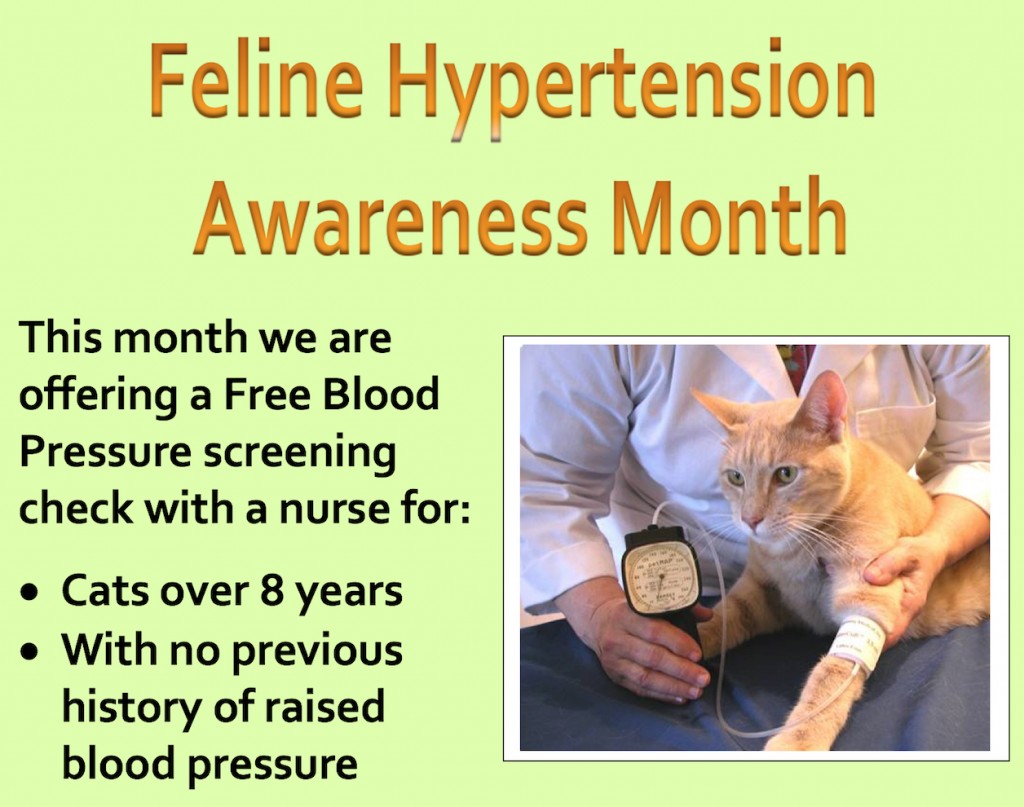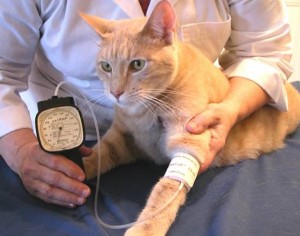News
Archive for May, 2018
Special Offer – May – Feline Hypertension Month
by admin on May 1st, 2018
Category: Special Offers, Tags:
Pet of the month – May – Pepper
by admin on May 1st, 2018
Category: Pet of the Month, Tags:
Pepper is Pet of the Month for May. She is a rescue dog with a chequered past who has recently found a good home. Her new owner is making good progress dealing with her separation anxiety.
Separation anxiety and behavioural problems can occur in dogs when they are left home alone.
Dogs are social creatures that have evolved to live with humans. It isn’t surprising therefore that unwanted behaviour sometimes occurs when a dog or puppy is left ‘home alone’. However, whilst it is often assumed that the problem behaviour is triggered by ‘separation anxiety’, this is not always the case. It is therefore very important that the reason for the unwanted behaviour is clearly identified for each individual.
What sort of problem behaviour is typically seen?
The most commonly reported separation problems in dogs are excessive barking or howling, eliminating indoors and damage to the house or its contents. Dogs may also show physical symptoms such as excessive salivation, or compulsive behaviours such as pacing or excessively licking themselves. Most start to show the problem behaviour as soon as the owner has left, but others may not do so for some time or may start to feel distressed as soon as they realise the owner is about to go out. They may then try to stop them leaving, perhaps by blocking their access to the door or – rarely – by becoming aggressive.
What causes separation anxiety or other problem behaviour when a dog is left alone?
Dogs may show unwanted behaviour when alone for a wide variety of reasons. For example elimination may be an involuntary reflex reaction due to separation anxiety. However, it may also occur because the dog isn’t properly house trained and so eliminates if he is caught short whilst the owner is out. It may be due to a urinary tract infection or another medical problem that makes the dog need to eliminate more often. In geriatric dogs it may be due to declining mental faculties resulting in confusion about when or where to eliminate.
Separation anxiety and other problem behaviour when a dog is home alone may occur for a wide variety of reasons
Destructive behaviour when left alone, such as when the dog scrabbles at a door or window, may be caused by the dog trying to follow the owner due to separation anxiety. Alternatively, the dog may chew out of boredom or may cause damage whilst trying to get to something he wants. It also isn’t uncommon for a dog to spend a happy afternoon raiding the cupboards and fridge when left alone in the kitchen, but to settle perfectly happily if left in a room where there is no access to food. This is more a case of ‘whilst the cat’s away….’ than emotional distress.
Vocalisation may also have multiple causes. Dogs vocalise to communicate and may howl or bark for prolonged periods due to separation anxiety. However, they are also likely to bark if someone approaches the property and they are trying to guard it. It therefore can’t always be assumed any barking or howling is triggered by emotional distress at being alone.
Even where the unwanted behaviour is triggered by emotional distress, this may arise for different reasons in different dogs. Some dogs appear to become overly attached to or dependant on their owner. These dogs seem genuinely distressed at being separated from them. In other cases the distress may be because the dog didn’t learn to feel comfortable being alone as a puppy. He may then become distressed the first time this happens, such as when a family member returns to work or a doggy (or feline) companion dies. Some may bark and scrabble at doors out of frustration because they want to accompany the owner on their adventure into the wide world outside. In a few cases the unwanted behaviour is triggered by something happening when the owner is out that makes the dog scared. This can then lead to the dog becoming fearful whenever they are alone in case it happens again.
How do we know what is causing the separation anxiety or other problem behaviour?
Finding the causes for separation anxiety (or other problem behaviour) requires a careful assessment of what is happening when the dog is both with people and alone. Video recordings of the dog’s behaviour when no-one is there can also be very revealing.
For example if a dog causes damage to doorways as soon as and every time the owner leaves, this is likely to be due to some kind of emotional distress. Observation of the behaviour will show if it is due to anxiety or frustration, and the dog’s history will reveal if it’s due to lack of familiarisation as a puppy or over attachment. If the behaviour doesn’t occur until much later, is directed to household contents and occurs in a young or under exercised dog, it is more likely to be boredom. If the behaviour is intermittent, video recordings may reveal certain triggers for the behaviour, such as when bins are collected in a dog with a phobia of lorries.
How can we prevent separation anxiety and other separation problems in dogs?
Most puppies can be familiarised to being home alone if they are taught to gradually accept this when they are very young. Other problem behaviours can be prevented by teaching your dog to prefer being outside when he wants to eliminate and making sure he has plenty of exercise, stimulation and companionship.
Top tips to help familiarise puppies to being home alone
- Start by leaving when your puppy is tired, well fed and has just been out into the garden
- Place your puppy in a safe area such as his crate or a puppy proofed area of the house
- Give your puppy something engaging e.g. a new toy, or a food item such as a Kong with a small amount of food inside
- Leave calmly but don’t sneak away – it is important that your puppy knows you have gone
- Initially leave for just five minutes. Make sure you are somewhere your puppy cannot hear, see or smell you
- Come back after the allotted time regardless of what is happening e.g. barking or whining
- If your puppy is quiet he can be greeted immediately
- If he is making noise ask him to ‘sit’, then give attention when he obeys. If he doesn’t yet know this command just wait for him to be quiet then greet him. Don’t ignore him for long periods as this is punishing
- Repeat 3-4 times a day. He should quickly stop being concerned by you leaving and settle to his toy or food item
- You can then start to increase how long he is left for. Start by increasing this by five minutes at a time, up to 30 minutes, then by 10 minutes at a time up to an hour. Each increment should be repeated 3 or 4 times. As the duration he is left for goes up the frequency can reduce
- Even puppies that live with another dog must learn to be alone
How can we stop this behaviour?
If prevention hasn’t worked then the method of correction will depend on the cause. For example, if indoor elimination is due to a lack of house training this can be rectified by teaching the dog to prefer to be outside to eliminate using similar methods to those used with puppies. If the dog is being destructive due to boredom this may be helped with toys, improvements in overall exercise and stimulation or reducing the period of time the dog is left alone. However more complex problems may require a tailored treatment package developed specifically for your dog’s needs by a specialist in this area. If your pet is showing problem behaviour when left alone then discuss this with your vet. They will be able to rule out any underlying medical problems and, if necessary, refer you to a suitably qualified behaviour expert.
FELINE HYPERTENSION
by admin on May 1st, 2018
Category: News, Tags:
To encourage awareness of Feline Hypertension this month we are offering the owners of all cats over 8 years of age with no previous history of hypertension a FREE Screening test with one of our nurses.
Hypertension, or high blood pressure, usually occurs in cats secondary to other diseases. The most common diseases to cause high blood pressure in cats are chronic renal failure (kidney disease), hyperthyroidism and anemia. Cushing’s disease and certain forms of cancer can also cause high blood pressure.
Hypertension is a serious problem in the cat, as it can cause blindness and strokes, just as in people. The first symptom seen is usually sudden blindness from retinal detachment – the high blood pressure literally blows out the back of the eye. If retinal detachment is caught early, with prompt and aggressive drug treatment the retina will sometimes reattach itself at least partially, and some vision will be restored. Many cats, however, will be permanently blind as a result. Owners will sometimes notice the cat’s pupils are fixed and fully dilated, or only respond very slowly and sluggishly to light. This is an emergency situation which should be treated as soon as possible.
The other common symptom of untreated high blood pressure is bleeding into the brain. Cats may suddenly show signs of disorientation, circling around and around in one spot, or otherwise acting strange. Some cats will wander the house crying as if distressed.
Ideally, high blood pressure should be diagnosed and treated before the cat becomes blind or suffers brain damage. If your cat has been diagnosed with chronic renal failure, hyperthyroidism or anemia, a blood pressure check will probably be recommended as well.
Some cats with high blood pressure will have heart murmurs or abnormal heart rhythms. If your veterinarian picks up a heart murmur or arrhythmia in a cat, especially an older cat prone to kidney or thyroid disease, a blood pressure check will be recommended. We may also pick up on high blood pressure when we draw a blood sample – if the blood gushes into the syringe without our having to pull back on the
plunger, the cat’s blood pressure is probably very high.
About 65% of cats with chronic renal failure have some degree of hypertension. This is a serious problem because hypertension in turn worsens the kidney disease. It becomes a vicious cycle in which the high blood pressure worsens the kidney disease, which increases the blood pressure even more, which then worsens the kidney disease, etc. Any cat diagnosed with chronic renal disease should have a blood pressure check on a regular basis.
In cats with hyperthyroidism the hypertension is usually temporary. Once the thyroid disease is controlled with medication or radiation treatment, the blood pressure goes back down. Treatment for high blood pressure in this disease is usually only needed for a few weeks to months. Treatment is still important, however, to prevent blindness and brain damage.
Although blood pressure measuring is important to monitor, it can also be difficult to do accurately in cats. Most cats are stressed and nervous at the veterinary clinic, and some are hostile. Blood pressure readings will probably be higher than they would be if measured when the cat was at home in its own environment. If a cat is aggressive or terrified, readings may not be possible at all. We will advise you as to whether an accurate blood pressure reading is possible in your cat.
We try to make the experience as stress free as possible, in a quiet room. The measurement itself is painless, just as it is in humans, but the cat may be frightened by the procedure. The cat needs to be held still, and a Doppler monitor is used to get the measurement. The monitor makes a noise which may frighten to some cats. The feeling of the cuff on the leg also makes some cats nervous, as does being held.
The goal of treatment is to decrease the blood pressure gradually to avoid a sudden decrease in blood flow to the kidneys, which will make kidney disease worse. In cats with chronic renal failure and high blood pressure, the pressure should be rechecked every 3-7 days, depending on how good the first reading was. Once two good readings on two successive visits are obtained, the cat is considered stable on the medication. The blood pressure is then rechecked along with kidney blood testing about every three months. Drug treatment will be necessary for the rest of the cat’s life.
There are two medications commonly used to treat hypertension. Amlodipine is usually tried first. If the response is not adequate, we may switch to benazapril. Occasionally, a cat will need both amlodipine and benazapril to control the high blood pressure.
For cats with chronic renal failure but a normal first blood pressure check, rechecks are recommended every 6-12 months. Hypertension may show up later in the course of the disease, as kidney function gradually worsens with time. In cats recently diagnosed with hyperthyroidism, the blood pressure may be high. If affirmative we will prescribe a two to three week course of blood pressure medication for the cat while the thyroid level is coming down in response to treatment. Once the thyroid level is back in the normal range, the medication can usually be stopped.
Cats that have already suffered blindness or visual impairment from hypertension usually get around well in their own home with some modifications to the environment. Your cat may not be able to find its way to the basement litter tray any more but blind cats rarely stop using the tray as long as it is accessible to them. Be sure the food and water bowls are also accessible without climbing or jumping. Dabbing some perfume or cologne on table legs and doorways once a week at first with help your pet to smell where it’s going and makes navigation easier.
Be sure to call us if you have trouble administering your cat’s medication or you notice any change. We are always glad to help!
See website: http://www.amodeus.vet for further information




